Related Research Articles

An asteroid is a minor planet—an object that is neither a true planet nor an identified comet— that orbits within the inner Solar System. They are rocky, metallic, or icy bodies with no atmosphere, classified as C-type (carbonaceous), M-type (metallic), or S-type (silicaceous). The size and shape of asteroids vary significantly, ranging from small rubble piles under a kilometer across and larger than meteoroids, to Ceres, a dwarf planet almost 1000 km in diameter. A body is classified as a comet, not an asteroid, if it shows a coma (tail) when warmed by solar radiation, although recent observations suggest a continuum between these types of bodies.

Vesta is one of the largest objects in the asteroid belt, with a mean diameter of 525 kilometres (326 mi). It was discovered by the German astronomer Heinrich Wilhelm Matthias Olbers on 29 March 1807 and is named after Vesta, the virgin goddess of home and hearth from Roman mythology.
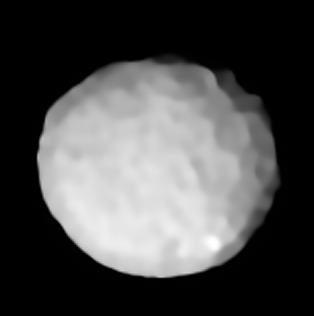
Pallas is the third-largest asteroid in the Solar System by volume and mass. It is the second asteroid to have been discovered, after Ceres, and is likely a remnant protoplanet. Like Ceres, it is believed to have a mineral composition similar to carbonaceous chondrite meteorites, though significantly less hydrated than Ceres. It is 79% the mass of Vesta and 22% the mass of Ceres, constituting an estimated 7% of the mass of the asteroid belt. Its estimated volume is equivalent to a sphere 507 to 515 kilometers in diameter, 90–95% the volume of Vesta.

The asteroid belt is a torus-shaped region in the Solar System, centered on the Sun and roughly spanning the space between the orbits of the planets Jupiter and Mars. It contains a great many solid, irregularly shaped bodies called asteroids or minor planets. The identified objects are of many sizes, but much smaller than planets, and, on average, are about one million kilometers apart. This asteroid belt is also called the main asteroid belt or main belt to distinguish it from other asteroid populations in the Solar System.

Dawn is a retired space probe that was launched by NASA in September 2007 with the mission of studying two of the three known protoplanets of the asteroid belt: Vesta and Ceres. In the fulfillment of that mission—the ninth in NASA's Discovery Program—Dawn entered orbit around Vesta on July 16, 2011, and completed a 14-month survey mission before leaving for Ceres in late 2012. It entered orbit around Ceres on March 6, 2015. In 2017, NASA announced that the planned nine-year mission would be extended until the probe's hydrazine fuel supply was depleted. On November 1, 2018, NASA announced that Dawn had depleted its hydrazine, and the mission was ended. The derelict probe remains in a stable orbit around Ceres.

Planetary geology, alternatively known as astrogeology or exogeology, is a planetary science discipline concerned with the geology of celestial bodies such as planets and their moons, asteroids, comets, and meteorites. Although the geo- prefix typically indicates topics of or relating to Earth, planetary geology is named as such for historical and convenience reasons; due to the types of investigations involved, it is closely linked with Earth-based geology. These investigations are centered around the composition, structure, processes, and history of a celestial body.
Christopher Thomas Russell is head of the Space Physics Center at the Institute of Geophysics and Planetary Physics (IGPP) at UCLA, professor in UCLA's Department of Earth, Planetary, and Space Sciences, and Director of the UCLA Branch of the California Space Grant Consortium. He received a B.Sc. from the University of Toronto in 1964 and a Ph.D. from UCLA in 1968. In 1977 he was awarded the James B. Macelwane Medal and in 2003 the John Adam Fleming Medal by the American Geophysical Union (AGU). He is also a Fellow of the AGU. Asteroid 21459 Chrisrussell was named after him in 2008. In 2017, he was awarded the NASA Distinguished Public Service Medal. He has three grandchildren.
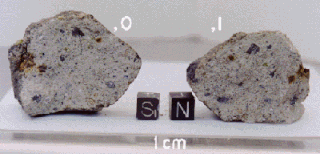
HED meteorites are a clan (subgroup) of achondrite meteorites. HED stands for "howardite–eucrite–diogenite". These achondrites came from a differentiated parent body and experienced extensive igneous processing not much different from the magmatic rocks found on Earth and for this reason they closely resemble terrestrial igneous rocks.

Ceres is a dwarf planet in the middle main asteroid belt between the orbits of Mars and Jupiter. It was the first known asteroid, discovered on 1 January 1801 by Giuseppe Piazzi at Palermo Astronomical Observatory in Sicily, and announced as a new planet. Ceres was later classified as an asteroid and then a dwarf planet, the only one not beyond Neptune's orbit.

A dwarf planet is a small planetary-mass object that is in direct orbit around the Sun, massive enough to be gravitationally rounded, but insufficient to achieve orbital dominance like the eight classical planets of the Solar System. The prototypical dwarf planet is Pluto, which for decades was regarded as a planet before the "dwarf" concept was adopted in 2006.
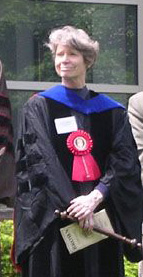
Carle McGetchin Pieters is an American planetary scientist. Pieters has published more than 150 research articles in peer-reviewed journals and was co-author of the book Remote Geochemical Analyses: Elemental and Mineralogical Composition along with Peter Englert. Her general research efforts include planetary exploration and evolution of planetary surfaces with an emphasis on remote compositional analyses.

Rheasilvia is the largest impact crater on the asteroid Vesta. It is 505 km (314 mi) in diameter, which is 90% the diameter of Vesta itself, and is 95% the mean diameter of Vesta, 529 km (329 mi). However, the mean is affected by the crater itself. It is 89% the mean equatorial diameter of 569 km (354 mi), making it one of the largest craters in the Solar System, and at 75°S latitude, covers most of the southern hemisphere. The peak in the center of the crater is 200 km (120 mi) in diameter, and rises 22.5 km from its base, making it one of the tallest mountains known in the Solar System.

Vibidia is an impact crater on the asteroid 4 Vesta, located at 26.9°S and 139.9°W. It has a diameter of 7.1 km. There is a distinctive ray-like pattern of bright and dark material, with the bright rays extending circularly for 15 km around Vibidia, and the dark rays mostly restricted to within the crater and on the rim. The rays cut across older craters, whereas a few younger craters have formed on top of them.
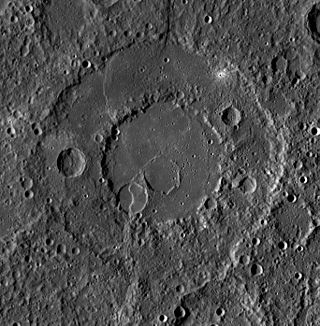
Renoir is a crater on the planet Mercury. Its name, after the French painter Pierre-Auguste Renoir (1841–1919), was adopted by the International Astronomical Union in 1976.
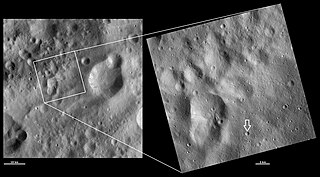
Claudia is a small crater that formerly defined the prime meridian of the asteroid 4 Vesta. The convention of defining Vesta's prime meridian from Claudia is informally referred to as the Claudia coordinate system. The crater was named after the Roman Vestal Virgin Claudia by the Dawn mission team; the name Claudia was officially approved by the IAU on 30 September 2011.
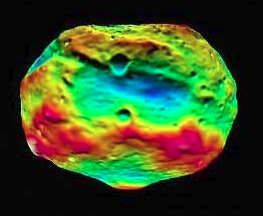
Feralia Planitia is the third-largest known impact structure on the asteroid Vesta, after Rheasilvia and Veneneia. It is one of several old, degraded impact basins that predate the Rheasilvia basin that now dominates Vesta. It is situated near the equator, and is 270 kilometres (170 mi) across east to west, though compressed latitudinally by the Rheasilvia impact.

Lucy-Ann Adams McFadden is an American astronomer and planetary scientist. An employee of the National Aeronautics and Space Administration, she also founded the Science, Discovery & the Universe Program within the University of Maryland, and the Explore-It-All Science Center, a children's science program.

The geology of Ceres is the scientific study of the surface, crust, and interior of the dwarf planet Ceres. It seeks to understand and describe Ceres' composition, landforms, evolution, and physical properties and processes. The study draws on fields such as geophysics, remote sensing, geochemistry, geodesy, and cartography.
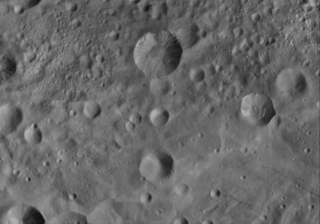
Vestalia Terra is a large highland plateau on the giant asteroid Vesta. Situated in Vesta's eastern hemisphere, Vestalia Terra is located near the equator and hosts the tallest point on Vesta. One of the largest named features on Vesta, it contains some of the most ancient terrain known on the asteroid. Additionally, Vestalia Terra is one of the few remaining magmatic features discovered on Vesta.
References
- ↑ Target: Vesta, Gazetteer of Planetary Nomenclature
- ↑ Schenk, Paul (2012). "The Geologically Recent Giant Impact Basins at Vesta's South Pole". Science. 336 (6082): 694–697. Bibcode:2012Sci...336..694S. doi:10.1126/science.1223272. PMID 22582256.
- ↑ Vega, P. (11 October 2011). "New View of Vesta Mountain From NASA's Dawn Mission". dawn.jpl.nasa.gov. NASA. Archived from the original on 2013-10-17. Retrieved 2018-02-17.
